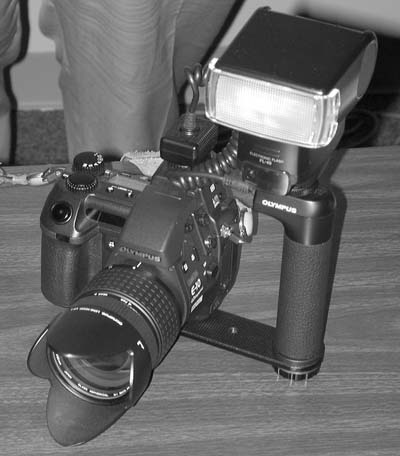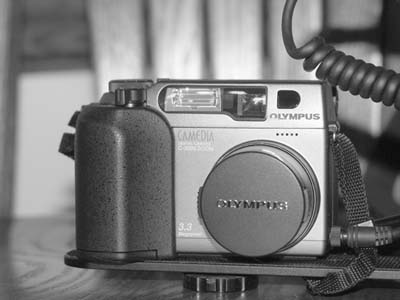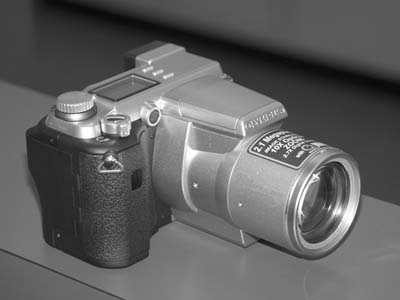DigiCam 102 -- A Tale of 3
Photographers
By Lou Pastura
Washington Apple Pi Journal, July/August 1999, p.
13, reprint
information
With all due respect (and sincere apologies!) to Charles
Dickens, when it come to choosing a digital camera, these
are, indeed, the best of times and the worst of times.
Selection and feature/price ratio have never been better.
The down side is that the plethora of choices makes a final
decision a daunting challenge.
In my last article I described an unfortunately (though
unavoidably) long list of issues, options and alternatives
to consider in deciding which digital camera is right for
you. This time I'd like to take you through the
process of analyzing your needs and wants and
selecting a camera that best fits your situation. Those of
you who derive great joy from complex multivariate analysis
should stop reading right here. My goal is to simplify the
process, not chart a murky path through outlandish
complexities. (Note: This is not a value
judgment...I'm one of those crazies who enjoys the research
as much as the result! I just hope that what I've learned
from four purchases and two upgrades might help you avoid
some of the pitfalls.) As you read further (those of you who
haven't already dropped the magazine in horror and run away
screaming), please bear in mind that there are no absolute
truths here. At the end, I'll describe three real world
situations that have had happy outcomes. I'll discuss what
the individuals selected and why. Your mileage may vary, so
apply this discussion to your personal situation with an
emphasis on what makes most sense for you, not what someone
else did.
Okay, enough with the disclaimers! There are 3
fundamental questions you need to answer in order to make an
informed digital camera selection:
- What's your budget?
- What do you want to photograph?
- What do you want to do with the results?
What's Your Budget?
This seems like a question so fundamental that it doesn't
bear mentioning...and to a large extent, it is. I raise it
as an issue only because you need to consider not only the
cost of the camera, but also the cost of all the goodies
you'll need or want to go along with it. These might
include:
- Archival Storage (e.g., CD-ROM writer)
- Extra Removable Memory
- Extra Batteries -- Note: Non-rechargeable Lithium
batteries are good for more shots, but they're
very expensive. NiMH batteries and a charger are
the most cost effective solution. Alkaline batteries are
useless. My solution is to use NiMH batteries in both my
camera and the external flash, carry two spare, fully
charged NiMH sets, and also carry a set of the Lithiums
for "emergencies". They have a really long shelf life, so
keeping a set in my camera bag is good insurance.
- External Battery Pack
- AC Adapter
- Add-on lenses
- Tripod
- Software for Cataloging Images
- Image Editing Software
- Additional Computer RAM (Image editing software likes
a lot of memory.)
- Color Printer
- Photo Paper
List the items above in three categories. Those that you
already have, those you need right away, and those you can
do without or wait for. The items in the middle category,
those you need right away, need to be factored in your base
budget. This reduces the amount you can spend for the
camera, but eliminates surprises that can be a shock to your
wallet.
What do you want to photograph?
This is the question that will have the greatest impact
on your decision. For example, are you a big vacationer? If
so, the size of the camera (smaller being better) might be
an important consideration. Do you have a desire to do
sports or nature photography? A camera with a long zoom lens
(or the capacity to attach one) would be a must. Also, a
lens that supports fast shutter speeds will enable you to
freeze action and reduce depth of field to intentionally
blur backgrounds (which makes your primary subject matter
stand out in sharp focus). Are you more of a snap shooter of
events and family gatherings? Something that's reasonably
portable and has lots of automatic features might be more to
your liking. Is close-up work something that appeals to you?
If so, you need to make sure the camera has good macro
capability.
None of the situations in the list above are mutually
exclusive. You'll likely want to get involved in more than
one, perhaps all of them. Inevitably there will need to be
compromises. A camera with a 10x zoom lens is not going to
fit in your shirt pocket. Also, the list above represents
examples, not the universe of possibilities. Go back and
look at the first article in this series, "DigiCam 101 -- A
Megapixel is NOT a Huge Pixel" (it's on the WAP web site if
you can't find the last Journal). Think about what's most
important to you and factor the most important
features into your decision in priority order. A three level
approach works well here, too. Consider features you
must have, those you would like to have and
those you don't care about.
What do you want to do with the results?
This last item is relatively straightforward compared to
the last two. However, it's critical enough that it merits
its own section. What you intend to do with your photographs
determines the resolution of the camera you need to buy,
which will be the fundamental driver of the cost associated
with this venture.
I discussed this in the previous article, so please bear
with me as I briefly repeat myself. If your intention is to
prepare photos for web publication or any other application
that will only result in viewing on computer, a low
resolution camera (640 x 480) will be more than enough, and
save you some money. Keep in mind, however, that if you're
going to need to do any editing or cropping, you'll be
throwing pixels away and need to start from a bigger file,
perhaps 1 or 2 megapixels. For printed output the rule of
thumb is one megapixel will produce an acceptable 4x6 print;
two megapixels will go to 5x7 and three will be okay at 8 x
10. These are not hard and fast numbers and different
camera/printer/paper combinations will do either better or
worse.
My best advice would be, if you can, to try some
alternatives and see what works best for you. Many local
camera stores will let you take some photos in the store,
save them to your own memory card, and take them home to
edit and print. While trying different cameras may take a
few trips to the store (you need to format the card in each
camera you test to be safe), you'll have the chance to work
with each camera on your list, get a feel for the ergonomics
and ease-of-use and have some real world output to help you
judge differences. Also, don't forget that you'll need some
way to transfer the files from your memory card to your
computer and/or printer. A friend with a card reader is a
possibility. You can either borrow the reader or ask your
friend to email the files to you.
The Real World
(OK, so I just wanted to use a title that showed I'm
pretty with it for an old guy...I can steal from MTV!)
Now I'd like to offer three scenarios in which the
prospective photographers used the process described above
and are all happy with the results. Since one of the
examples is me and the others consulted with me, all cameras
purchased were Olympus. As I may have mentioned before,
Olympus is pretty much all I work with and recommend. When I
find something I like better, I'll switch, but that hasn't
happened yet! If you disagree, write an article and tell all
of us why! (Or send me an email...if I get enough, I'll
publish the debate. My email address is
lou.pastura@wap.org.)
So let's apply our three questions to our photographers'
situations and see where we come out:
Photographer #1
- What's your budget? I don't really have a
strict limit on what I can spend, but I also can't
justify (even to myself, let alone my long-suffering
spouse) the cost of the high end "pro" digital SLRs. I
already have all the peripherals I need since this is an
upgrade from a digital camera I already own.
- What do you want to photograph? I'm
interested in a little bit of everything. I'd like to do
some outdoor work with wildlife that will require a long
focal length lens. External flash is a requirement
because I need the capability of bounce flash for
portraits. A camera with a great deal of manual control
would be a plus. Small size and light weight are not
important to me.
- What do you want to do with the results? I
want to be able to edit and perhaps crop the photo quite
a bit, so large file size is critical, as large as
possible. Most prints will be 8 x 10.
- What did you buy?
- Olympus E-10
- 3x Tele-Extender
- 1.45x Tele-Extender
- Wide Angle Adapter
- Olympus FL-40 Flash
- External Bracket and Cable for Flash
- 32MB Smart Media Card
- 128 MB Compact Flash Card
- Combination Smart Media and Compact Flash Car
Reader
- BIG Camera Case
- Explain: Just about the time I'd given up on
finding an SLR with great glass and lots of control for
less than $4-5000 (plus lenses!), along comes Olympus
with a 4 megapixel camera with everything I want for
$1999. A lot of money? Sure. But a lot of features and
capability, too. Size/weight were not an issue, since my
wife, about the same time, bought a different camera that
didn't require the assistance of a small moving company
to carry around. The additional lenses and flash, while
expensive, are of exceptional quality and give me
everything I'll need in almost any circumstance I can
think of for a long time to come. When I saw the quality
of the 4 meg files printed at 8 x 10 (the word "stunning"
gets used a lot) I was hooked.
|

|
|
Olympus E-10 camera (Photo by Lawrence I.
Charters, using a Nikon CoolPix 990 camera)
|
Photographer #2
- What's your budget? I'd like to spend less
than $800. I already have a printer, software, paper, and
other peripherals to get me started. Down the road I'll
want an external flash, extra batteries and an extra
memory card.
- What do you want to photograph? I'd
like to take snapshots of family and friends. I want a
camera that's easy to use in automatic mode, with good
auto focus and automatic exposure capability. It should
be reasonably light and portable, but not necessarily
shirt pocket size.
- What do you want to do with the results? I
will mostly view the photos on my computer and send them
to others via email. However, I will want to print some
out at 8 x 10, and the quality of those is important to
me.
- What did you buy?
- Olympus C-3000
- Olympus FL-40 Flash
- External Bracket and Cable for Flash
- 64MB SmartMedia Card
- 2 Sets of NiMH AA Batteries and a Charger
- Explain: I wanted something reasonably simple
to use and portable that would give me excellent printed
output at 8 x 10. 3.3 megapixels was the minimum
requirement. I wanted a 3x zoom so that I could
photograph our pets and achieve reasonable close-ups
without getting into their space in a way that might have
a negative impact on the picture. The external flash
supports use in lower light situations and the bounce
flash feature creates interesting effects and absolutely
eliminates red-eye, even from our pets, which can be
difficult to do with a normal flash, even with a red-eye
reduction feature. (Red-eye reduction also introduces an
unacceptable delay between pressing the shutter release
and actually taking the picture, even in film
cameras.)
|

|
|
Olympus C-3000Z camera. (Photo by Lou Pastura)
|
Photographer #3
- What's your budget? The farther I can get
under $1000 the better. I already have a computer and a
printer. I'll need extra batteries and a charger, and an
extra memory card right away. I may add a card reader
later, if I'm not happy with the direct (USB) connection
between my camera and computer.
- What do you want to photograph? Both my
children are very active in sports, soccer and
basketball. My primary goal is to capture their sports
activities, but I also want something I can take on
family outings and vacations. Event photography, in the
form of birthdays, holidays, and so forth is also
important to me.
- What do you want to do with the results? I
want to be able to do limited editing to spruce up
printed output at 8 x 10, but I don't think I'll be doing
any serious cropping.
- What did you buy?
- Olympus C-2100UZ
- 32 MB Smart Media Card
- 1 Set of NiMH AA Batteries and a Charger
- Olympus Fitted Camera Case
- Explain: The C-2100UZ has a 10x zoom that's
electronically stabilized to eliminate blurring due to
camera movement. Although it's 2 megapixels, rather than
the 3 I'd prefer, I tested the output at 8 x 10 on my
printer and good quality photo paper and it's quite good.
It's not shirt pocket size for taking on trips, but the
zoom was more important to me than the small size and the
carrying case will make it easier to transport while
protecting it from bumps and the elements.
|

|
|
Olympus C-2100UZ camera. (Photo by Lou Pastura)
|
So that's how three folks coped. One last reminder, the
Internet is a great source of information to help you
decide. I mentioned the following 3 sites, among others, in
my last article. This time I'll refer you to specific areas
in these sites that are more relevant to this part of your
"quest."
- http://www.shortcourses.com -- This site has four
sections you might want to review:
- Editor's Choice -- The Best Digital Cameras
- A Short Course in Choosing a Digital Camera
- Everything You Wanted to Know about Batteries
- Digital Camera Pocket Guides. (The guides are
intended as supplements to/summaries of the
manufacturer's manuals. If there's a guide for a camera
you're interested in, reviewing it can give you a good
feel for ergonomics, features and ease of use.)
- http://www.steves-digicams.com/hardware_reviews.html
and http://www.dpreview.com/reviews/--These two sites
provide what I think are the best reviews with the most
detailed information on features and operations.
There are lots more resources out there, including sites
and discussion groups devoted to the individual cameras. As
always, take what you read from fanatics, including me, with
a grain of salt and just a little skepticism. Also, limit
the data you try to absorb and analyze. There's so much out
there you can become paralyzed and thus incapable of
reaching a decision. Remember, the goal is not to spend time
shopping, it's to have fun taking pictures. Enjoy the
search, enjoy the result and write to me and let me know if
all this helped. Tell me what you bought and why. Maybe
you'll be in next month's article!
- Camera: Olympus E-10 SLR
- Maximum Resolution: 2240 x 1680 (4 MP)
- Optical Zoom: 4x
- Dimensions: 5.0 x 4.1 x 7.0 inches
- Weight: 37 ounces (without batteries and memory
cards)
- Price: $1999
-
- Olympus C-3000Z
- 2048 x 1536 (3 MP)
- Optical Zoom: 3x
- Dimensions: 4.3 x 3 x 2.6 inches
- Weight: 10.6 ounces (without batteries and SmartMedia
card)
- Price: $699
-
- Olympus C-2100UZ
- 1600 x 1200 (2 MP)
- Optical Zoom: 10x (Stabilized)
- Dimensions: (4.5 x 3.1 x 5.6 inches
- Weight: 19 ounces (without batteries and SmartMedia
card)
- Price: $799
|



